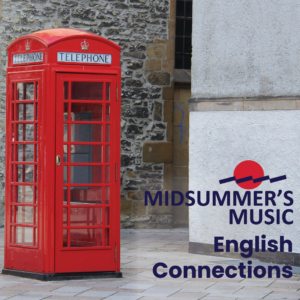 Our English Connections program, which starts with the first of four concerts this Thursday, is “connected” largely by one person—Charles Villiers Stanford. Stanford and Edward Elgar were the two greatest English composers at the turn of the 19th into the 20th century. However, Stanford was also a great teacher who thereby connected with a large group of the next generation of British composers including Vaughan Williams who is also on our program.
Our English Connections program, which starts with the first of four concerts this Thursday, is “connected” largely by one person—Charles Villiers Stanford. Stanford and Edward Elgar were the two greatest English composers at the turn of the 19th into the 20th century. However, Stanford was also a great teacher who thereby connected with a large group of the next generation of British composers including Vaughan Williams who is also on our program.
Born in Dublin, Stanford came to London to attend music school but was eventually convinced that he would get better instruction in Germany. He spent several years there studying first with Carl Reinicke, whose teaching he was not fond of, and then he found Friedrich Kiel (whom we featured on our previous program). Kiel’s teaching gave Stanford insights into the latest styles and techniques being used in Germany, which he took back to his London studio.
Stanford wrote in just about every genre—nine operas, seven symphonies, six Irish Rhapsodies for orchestra, concertos, chamber music, and sacred music. I first came in contact with his music as a college student when I sang in an Episcopal church choir. Stanford’s contribution to Anglican church music is considerable. I became aware of his hymn settings, anthems, and service music before I knew anything else about him; however, I was also aware that he had three names! He was never just Charles Stanford. Just like Wolfgang Mozart and Johann Bach, he had to have three names, so he was in good company.
Like the two German composers on our first program, Stanford really excelled at chamber music, and the string quintet we have chosen is among his very best. However, we almost had to ditch it from the program. I never dreamed that a work of this caliber by such a highly regarded composer would not be published! But, when we went to order it, it was nowhere to be found. We decided that we would have to change to another quintet of Stanford’s for the same combination—a fine piece but not one with the pathos and depth of emotion of the second one. I was disappointed but went ahead and wrote another set of program notes for the substitute quintet. Then Noah, from our office, put on his sleuthing glasses and went to work. I had a recently made recording of the work, so we knew the group who did the recording had the music. Noah tracked them down and got in touch with the British musicologist (no small feat) who had made the performing edition they used, which was made using the original manuscript, and managed to get him to send us the material. So, in all likelihood, we will be presenting the U.S. premiere of one of the finest pieces of chamber music ever written, even if it is over 100 years after it was first composed. Thank you, Noah! We managed to get confirmation that we would get the music just in time to include it in our program book before it went to the printer.
Ralph Vaughan Williams (another three-name guy), is perhaps the best known of Stanford’s many students, along with Gustav Holst, Rebecca Clarke, Arthur Bliss, Frank Bridge, and many more. Vaughan Williams’ quintet is in the form or a fantasy and comes from right after he wrote his first big success, “The Lark Ascending,” for solo violin and string orchestra. In fact, if you are familiar with Lark Ascending, you might recognize a phrase or two in this quintet that are cut from the same cloth.
For the first composer on our program, the English Connection is a bit stretched, but it also shows the extraordinary reach of Stanford. In the early 20th century, Stanford’s most famous former student, one who for a time was a real rock-star, was Samuel Coleridge-Taylor. He wrote Hiawatha’s Wedding Feast, which swept first England, then the Continent, and finally the U.S. As a kind of oratorio, it became as well known and often performed as Handel’s Messiah.
Coleridge-Taylor, who was black, was hailed everywhere he went and was invited to the White House on one of his extended trips to America by President Theodore Roosevelt. Unfortunately, Coleridge-Taylor died at 37, and his star quickly faded from the scene. However, his impact was felt so strongly that a young American mother decided to name her newborn son after Coleridge-Taylor, and that young man grew into a fine musician. His name is Coleridge-Taylor Perkinson, and you have heard his music in many movies and on TV programs. For this program, you are going to hear his use of the African American spiritual, “Calvary,” in a short, three-movement string quartet that is both poignant and energetic.
You can hear English Connections Thursday, June 16th, at St. Luke’s Episcopal Church in Sister Bay (7:00pm); Sunday, June 19th, at Woodwalk Gallery, Egg Harbor (5:00pm); Tuesday, June 21st, at Fish Creek’s Historic Town Hall, (5:00 pm with an optional dinner after at Alexander’s, if desired); and Thursday, June 23rd, at the Kress Pavilion, Egg Harbor (7:00 pm). Please join us for some compelling and enchanting music by visiting our website – www.midsummersmusic.com – or by calling 920.854.7088.
Jim Berkenstock
